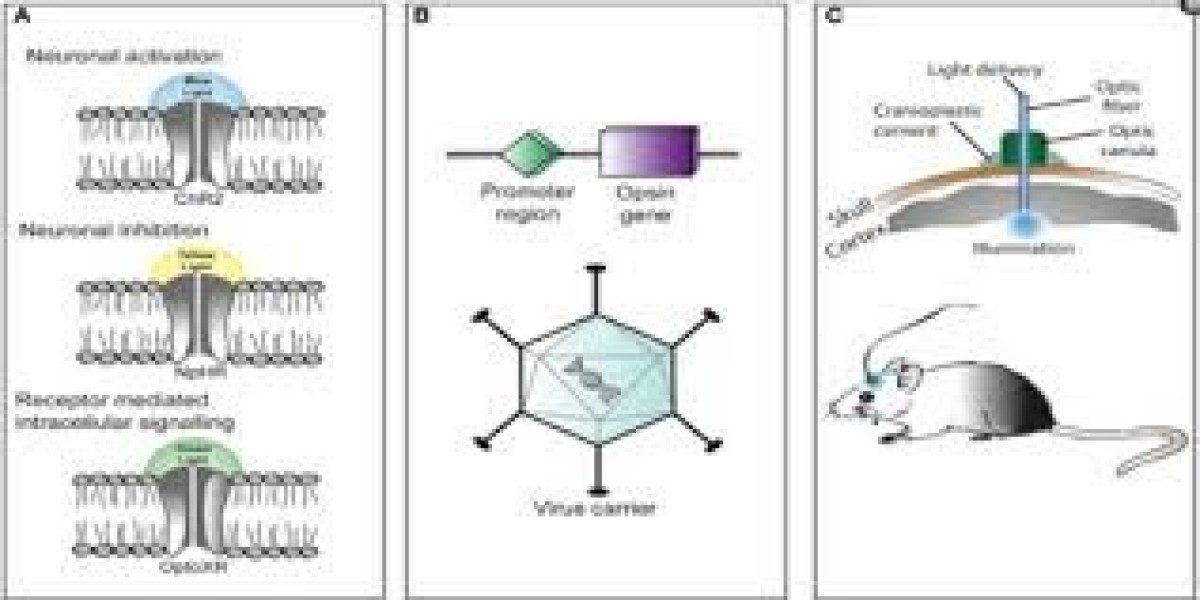Optogenetics is a groundbreaking technique that combines genetics and light to control and monitor the activity of specific neurons or cells within the brain and nervous system. By utilizing light-sensitive proteins called opsins, researchers can manipulate neuronal activity with incredible precision, leading to remarkable advancements in neuroscience. This powerful tool is transforming the way scientists study brain function, behavior, and even explore potential treatments for a wide range of neurological and psychiatric disorders. In this article, we will explore what optogenetics is, its underlying principles, applications, challenges, and future directions.
What is Optogenetics?
Optogenetics is a technique that allows scientists to control the activity of individual neurons in living organisms using light. The key to this method is the use of opsins, which are proteins that are sensitive to specific wavelengths of light. The two most commonly used types of opsins in optogenetics are channelrhodopsins and halorhodopsins. These proteins are typically introduced into specific populations of neurons through genetic modification, allowing researchers to selectively activate or inhibit these cells when exposed to light.
Channelrhodopsins: These opsins are activated by blue light and cause neurons to depolarize, which leads to an increase in neural firing. This activation allows scientists to stimulate specific neurons, mimicking natural neural activity.
Halorhodopsins: On the other hand, halorhodopsins are activated by yellow or green light and cause the inhibition of neurons by hyperpolarizing the cell. This inhibition allows scientists to suppress specific neurons to study the effects of their silencing.
The ability to use light to control neurons with precise timing and spatial accuracy makes optogenetics a powerful tool for studying complex neural circuits in ways that were previously impossible with traditional techniques.
The History of Optogenetics
The development of optogenetics can be traced back to the discovery of light-sensitive proteins in algae and bacteria. In the early 2000s, researchers Karl Deisseroth, Ed Boyden, and their colleagues made a breakthrough by adapting these proteins to manipulate neurons in the brain. This was a revolutionary moment, as it enabled scientists to control brain activity with light in a non-invasive manner.
The first successful application of optogenetics in neuroscience was demonstrated in 2005 when Deisseroth's lab used channelrhodopsin-2 (ChR2) to activate neurons in a mouse brain. This milestone demonstrated that researchers could use light to control neuronal activity with pinpoint precision, leading to the rapid adoption of optogenetics in neuroscience research.
Since then, advancements in genetic engineering, light delivery methods, and optogenetic tools have further refined the technique, allowing it to be applied to a broad range of species and brain regions. Today, optogenetics is considered one of the most transformative techniques in neuroscience.
How Optogenetics Works
The optogenetics process begins by introducing opsins into the neurons of interest. This is usually achieved by using viral vectors, which are modified viruses that carry the genetic material encoding the opsins. These vectors are injected into specific areas of the brain or nervous system, where they infect targeted neurons, prompting them to express the opsins on their membranes.
Once the opsins are expressed in the neurons, the brain is ready for light-based manipulation. Researchers use light sources such as lasers or fiber optics to illuminate specific brain regions with the appropriate wavelength of light. The precise timing of light exposure allows for high-level control over neuronal activity, enabling researchers to activate or inhibit specific neural circuits.
For example, researchers might use optogenetics to activate neurons in the prefrontal cortex while observing the effects on behavior or cognition. By turning on and off specific neural circuits, optogenetics offers insights into how these circuits contribute to various brain functions, from simple reflexes to complex cognitive processes like decision-making.
Applications of Optogenetics
Optogenetics has opened up new avenues for understanding the brain and its associated behaviors. Some of the most important applications of optogenetics include:
1. Mapping Neural Circuits
The human brain contains roughly 86 billion neurons, and understanding how these neurons are organized and how they communicate is crucial to understanding brain function. Optogenetics allows researchers to selectively activate or inhibit specific neural circuits, providing a unique tool to map how different brain regions interact and how information flows within the brain.
By selectively activating neurons in the visual cortex, for instance, scientists can investigate how sensory information is processed and transmitted. Similarly, researchers have used optogenetics to map the motor circuits involved in movement and to explore how the brain coordinates voluntary motor actions.
2. Understanding Brain Disorders
Optogenetics has been instrumental in understanding a wide variety of neurological and psychiatric disorders, such as Parkinson’s disease, epilepsy, schizophrenia, and depression. By manipulating the neural circuits involved in these disorders, scientists can gain insights into their underlying mechanisms and develop potential therapeutic strategies.
Parkinson’s Disease: In Parkinson’s disease, the loss of dopaminergic neurons in the brain leads to motor symptoms like tremors and rigidity. Optogenetics has been used to restore function in animal models of Parkinson’s by stimulating specific regions of the brain involved in motor control, offering a potential pathway for new treatments.
Epilepsy: Seizures in epilepsy occur when neurons in the brain fire abnormally. Using optogenetics, researchers can selectively inhibit the neural circuits responsible for seizures, offering a promising method to treat drug-resistant epilepsy.
Depression: Depression has been linked to dysfunction in brain circuits that regulate mood and emotion. Optogenetics allows scientists to target specific neurons in areas such as the prefrontal cortex and amygdala, providing insights into how these regions contribute to mood disorders.
3. Behavioral and Cognitive Studies
Optogenetics has allowed researchers to study complex behaviors and cognitive functions in animals with unprecedented precision. By controlling specific neurons or neural circuits, scientists can investigate how the brain generates behaviors such as fear, reward, social interactions, and memory formation.
For instance, optogenetic techniques have been used to induce specific behaviors in animals, such as fear responses or the desire for reward. These studies help to map out the neural pathways involved in these behaviors, providing a deeper understanding of the brain’s role in emotions and decision-making.
Optogenetics has also been used to investigate memory formation. By manipulating neurons in regions like the hippocampus, researchers can observe how memory is encoded and retrieved, providing insights into cognitive processes that are fundamental to learning.
4. Pain Management
Pain is a complex sensory experience that involves multiple regions of the brain and spinal cord. Optogenetics offers a promising approach for studying and potentially alleviating chronic pain. By selectively targeting and inhibiting neurons in the pain pathways, researchers can explore how pain is processed and whether it is possible to reduce or eliminate pain perception without the use of drugs.
Studies have shown that optogenetics can effectively suppress pain in animal models by selectively inhibiting pain-related neural circuits. This approach holds potential for developing new, non-invasive treatments for chronic pain that do not carry the side effects associated with traditional pain medications.
Challenges and Ethical Considerations
Despite its immense potential, optogenetics does come with a few challenges and ethical concerns. Some of the major challenges include:
Technical limitations: Delivering light to deep brain structures in living organisms can be difficult. While fiber optics and miniature implants have made progress in this area, accessing deeper regions of the brain with precision remains a challenge.
Genetic modifications: Introducing genetic material into neurons requires careful control, as unwanted effects may occur if opsins are expressed in unintended cells. Achieving high specificity is essential to ensure the success and reliability of optogenetic experiments.
Ethical concerns: The ability to manipulate brain activity raises ethical questions about the potential for misuse. For example, the possibility of using optogenetics to alter an individual’s behavior, memories, or emotions could lead to significant ethical dilemmas. Additionally, the potential long-term effects of altering neural activity in this way are not fully understood, and more research is needed to assess any risks.
The Future of Optogenetics
As optogenetics continues to evolve, the field is moving towards several exciting future directions:
Gene-editing technologies: The integration of gene-editing tools like CRISPR-Cas9 into optogenetics holds great promise for further refining the technique. By enabling more precise and efficient modifications to the genome, CRISPR could help overcome some of the challenges associated with the delivery of opsins.
Optogenetics and brain-computer interfaces: Researchers are exploring the use of optogenetics in combination with brain-machine interfaces to create more effective prosthetic devices, allowing individuals to control external devices using only their thoughts. This could revolutionize the field of rehabilitation for people with neurological impairments.
Clinical applications: Although optogenetics is currently primarily used in animal models, there is growing interest in translating these techniques into human therapies. For example, optogenetics could potentially be used in the treatment of neurodegenerative diseases like Parkinson's, or in personalized medicine for psychiatric disorders such as depression or schizophrenia.
Conclusion
Optogenetics has emerged as one of the most transformative tools in modern neuroscience. Its ability to control specific neural circuits with light offers unparalleled insights into brain function, behavior, and disease. As the technology continues to advance, optogenetics holds the promise to not only expand our understanding of the brain but also provide new, more effective therapies for a range of neurological and psychiatric conditions. Despite some technical and ethical challenges, optogenetics has the potential to revolutionize neuroscience and medicine, paving the way for future breakthroughs in the understanding and treatment of brain disorders.









